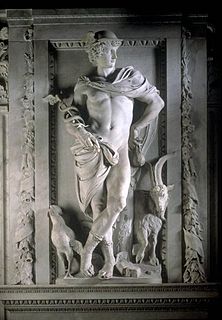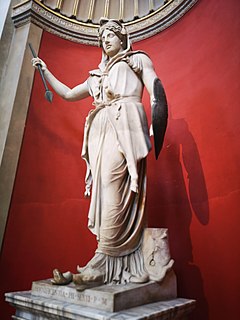Related Research Articles
Ancient Egyptian religion was a complex system of polytheistic beliefs and rituals that formed an integral part of ancient Egyptian society. It centered on the Egyptians' interactions with many deities believed to be present in, and in control of, the world. Rituals such as prayer and offerings were provided to the gods to gain their favor. Formal religious practice centered on the pharaohs, the rulers of Egypt, believed to possess divine powers by virtue of their positions. They acted as intermediaries between their people and the gods, and were obligated to sustain the gods through rituals and offerings so that they could maintain Ma'at, the order of the cosmos. The state dedicated enormous resources to religious rituals and to the construction of temples.

Mercury is a major god in Roman religion and mythology, being one of the 12 Dii Consentes within the ancient Roman pantheon. He is the god of financial gain, commerce, eloquence, messages, communication, travelers, boundaries, luck, trickery and thieves; he also serves as the guide of souls to the underworld. He was considered the son of Maia, who was a daughter of the Titan Atlas, and Jupiter in Roman mythology. His name is possibly related to the Latin word merx, mercari, and merces (wages); another possible connection is the Proto-Indo-European root merĝ- for "boundary, border" and Greek οὖρος, as the "keeper of boundaries," referring to his role as bridge between the upper and lower worlds. In his earliest forms, he appears to have been related to the Etruscan deity Turms; both gods share characteristics with the Greek god Hermes. He is often depicted holding the caduceus in his left hand. Similar to his Greek equivalent Hermes, he was awarded a magic wand by Apollo, which later turned into the caduceus, the staff with intertwined snakes.

Isis was a major goddess in ancient Egyptian religion whose worship spread throughout the Greco-Roman world. Isis was first mentioned in the Old Kingdom as one of the main characters of the Osiris myth, in which she resurrects her slain husband, the divine king Osiris, and produces and protects his heir, Horus. She was believed to help the dead enter the afterlife as she had helped Osiris, and she was considered the divine mother of the pharaoh, who was likened to Horus. Her maternal aid was invoked in healing spells to benefit ordinary people. Originally, she played a limited role in royal rituals and temple rites, although she was more prominent in funerary practices and magical texts. She was usually portrayed in art as a human woman wearing a throne-like hieroglyph on her head. During the New Kingdom, as she took on traits that originally belonged to Hathor, the preeminent goddess of earlier times, Isis was portrayed wearing Hathor's headdress: a sun disk between the horns of a cow.

In ancient Roman religion and mythology, LiberLY-bər, Latin: [ˈliːbɛr]; "the free one"), also known as Liber Pater, was a god of viticulture and wine, fertility and freedom. He was a patron deity of Rome's plebeians and was part of their Aventine Triad. His festival of Liberalia became associated with free speech and the rights attached to coming of age. His cult and functions were increasingly associated with Romanised forms of the Greek Dionysus/Bacchus, whose mythology he came to share.
In Roman mythology, Deverra was one of the three gods that protected midwives and women in labor, the other two being Pilumnus and Intercidona. Symbolised by a broom used to sweep away evil influences, she ruled over the brooms used to purify temples in preparation for various worship services, sacrifices and celebrations.
In Roman mythology, Picumnus was a god of fertility, agriculture, matrimony, infants and children. He may have been the same god as Sterquilinus. His brother was Pilumnus.
Latvian mythology is the collection of myths that have emerged throughout the history of Latvia, sometimes being elaborated upon by successive generations, and at other times being rejected and replaced by other explanatory narratives. These myths stem from folk traditions of the Latvian people and pre-Christian Baltic mythology.
A tutelary is a deity or spirit who is a guardian, patron, or protector of a particular place, geographic feature, person, lineage, nation, culture, or occupation. The etymology of "tutelary" expresses the concept of safety and thus of guardianship.

Religion in ancient Rome includes the ancestral ethnic religion of the city of Rome that the Romans used to define themselves as a people, as well as the religious practices of peoples brought under Roman rule, in so far as they became widely followed in Rome and Italy. The Romans thought of themselves as highly religious, and attributed their success as a world power to their collective piety (pietas) in maintaining good relations with the gods. The Romans are known for the great number of deities they honored, a capacity that earned the mockery of early Christian polemicists.

Ancient Greek religion encompasses the collection of beliefs, rituals, and mythology originating in ancient Greece in the form of both popular public religion and cult practices. These groups varied enough for it to be possible to speak of Greek religions or "cults" in the plural, though most of them shared similarities.

A flamen was a priest of the ancient Roman religion who was assigned to one of eighteen deities with official cults during the Roman Republic. The most important three were the flamines maiores, who served the important Roman gods Jupiter, Mars, and Quirinus. The remaining twelve were the flamines minores. Two of the minores cultivated deities whose names are now unknown; among the others are deities about whom little is known other than the name. During the Imperial era, the cult of a deified emperor also had a flamen.

Juno is an ancient Roman goddess, the protector and special counselor of the state. A daughter of Saturn, she is the wife of Jupiter and the mother of Mars, Vulcan, Bellona and Juventas. She is the Roman equivalent of Hera, queen of the gods in Greek mythology; like Hera, her sacred animal was the peacock. Her Etruscan counterpart was Uni, and she was said to also watch over the women of Rome. As the patron goddess of Rome and the Roman Empire, Juno was called Regina ("Queen") and was a member of the Capitoline Triad, centered on the Capitoline Hill in Rome; it consisted of her, Jupiter, and Minerva, goddess of wisdom.

Interpretatio graeca or "interpretation by means of Greek [models]" is a discourse used to interpret or attempt to understand the mythology and religion of other cultures; a comparative methodology using ancient Greek religious concepts and practices, deities, and myths, equivalencies, and shared characteristics.

Vahana denotes the being, typically an animal or mythical entity, a particular Hindu deity is said to use as a vehicle. In this capacity, the vahana is often called the deity's "mount". Upon the partnership between the deity and his vahana is woven much iconography and mythology. Deities are often depicted riding the vahana. Other times, the vahana is depicted at the deity's side or symbolically represented as a divine attribute. The vahana may be considered an accoutrement of the deity: though the vahana may act independently, they are still functionally emblematic or even syntagmatic of their "rider". The deity may be seen sitting or standing on the vahana. They may be sitting on a small platform called a howdah, or riding on a saddle or bareback. Vah in Sanskrit means to ride along the land.
Temple president is a priesthood leadership position in The Church of Jesus Christ of Latter-day Saints. A temple president's primary responsibility is to supervise the affairs of an LDS temple in both an administrative and spiritual capacity.

In ancient Roman religion, the indigitamenta were lists of deities kept by the College of Pontiffs to assure that the correct divine names were invoked for public prayers. These lists or books probably described the nature of the various deities who might be called on under particular circumstances, with specifics about the sequence of invocation. The earliest indigitamenta, like many other aspects of Roman religion, were attributed to Numa Pompilius, second king of Rome.

Roman mythology is the body of traditional stories pertaining to ancient Rome's legendary origins and religious system, as represented in the literature and visual arts of the Romans. "Roman mythology" may also refer to the modern study of these representations, and to the subject matter as represented in the literature and art of other cultures in any period.
References
- Michael Jordan, Encyclopedia of Gods, Kyle Cathie Limited, 2002
- Google Books - The Cult of Silvanus: A Study in Roman Folk Religion
| This article relating to an Ancient Roman myth or legend is a stub. You can help Wikipedia by expanding it. |